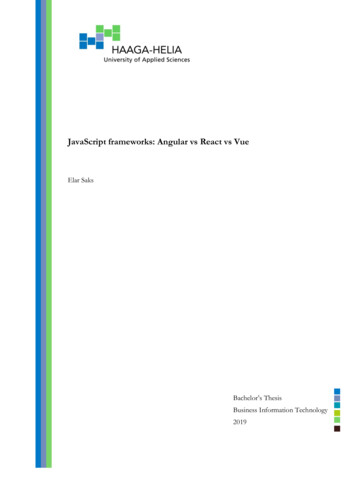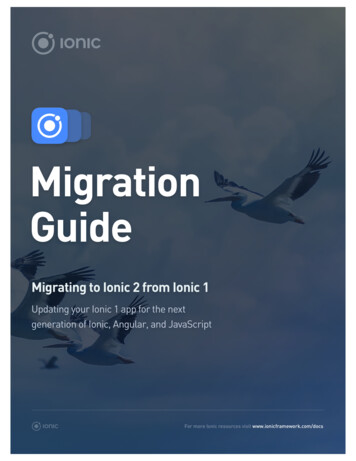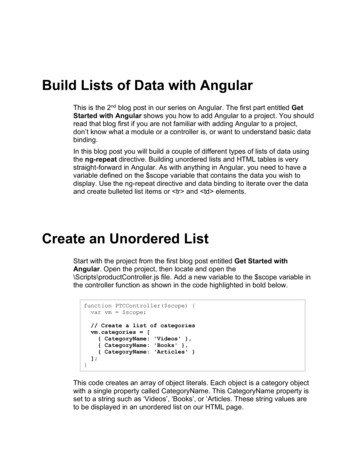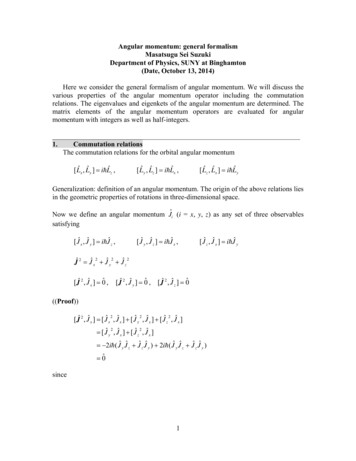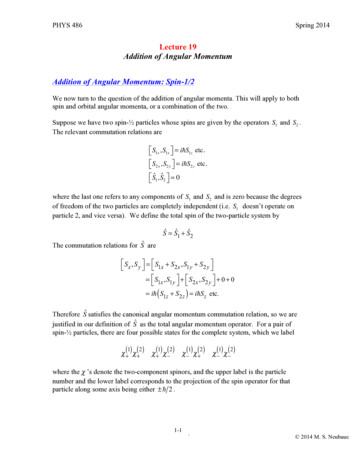
Transcription
PHYS 486Spring 2014Lecture 19Addition of Angular MomentumAddition of Angular Momentum: Spin-1/2We now turn to the question of the addition of angular momenta. This will apply to bothspin and orbital angular momenta, or a combination of the two.Suppose we have two spin-½ particles whose spins are given by the operators S1 and S2 .The relevant commutation relations are S1x ,S1y i!S1z etc. S2 x ,S2 y i!S2 z etc. Ŝ1 , Ŝ2 0 where the last one refers to any components of S1 and S2 and is zero because the degreesof freedom of the two particles are completely independent (i.e. S1 doesn’t operate onparticle 2, and vice versa). We define the total spin of the two-particle system byŜ Ŝ1 Ŝ2The commutation relations for Ŝ are S ,S S S ,S S 2x 1y2y x y 1x S1x ,S1y S2x ,S2 y 0 0 i! S1z S2z i!S z etc.()Therefore Ŝ satisfies the canonical angular momentum commutation relation, so we arejustified in our definition of Ŝ as the total angular momentum operator. For a pair ofspin-½ particles, there are four possible states for the complete system, which we labelχ ( ) χ (12)χ ( ) χ (12)χ ( ) χ (12)χ ( ) χ (12)where the χ ’s denote the two-component spinors, and the upper label is the particlenumber and the lower label corresponds to the projection of the spin operator for thatparticle along some axis being either ! 2 .1-1 2014 M. S. Neubauer
PHYS 486Spring 2014The spinors χ (1,2 ) satisfy(1) 1 1 (1)S12 χ 1 ! 2 χ 2 2 (1) ! (1)S1z χ χ 2and similarly for χ ( 2 ) and S2 , but note that S2 does not operate on χ (1) and S1 does notoperate on χ(2). Let’s check the eigenvalues of Sz for the four states(1) ( 2)) (1) (2)(S z χ χ S1z S2z χ χ (1) ( 2) (1) ( 2) S1z χ χ χ S2z χ Each term in parentheses on the right hand side gives ! 2 . Therefore we have(1) ( 2)(1) ( 2)S z χ χ !χ χ (1) ( 2)(1) ( 2)Sz χ χ Sz χ χ 0(1) ( 2)(1) ( 2)S z χ χ !S z χ χ There is one state with ms 1 , one with ms 1 and two with ms 0 . These statescan be grouped together into a triplet and a singlet. To help see how, let’s define theraising and lowering operator for the total spinand recallS S1 S2 S sm h s ( s 1) - ‐ m ( m 1) s m 1so(1,2) !χ (1,2)S 1,2 χ ( ) Now we apply S to the ms 1 state(1) ( 2) (1) ( 2) (1) ( 2) S χ χ S1 χ χ χ S2 χ (1) ( 2)(1) ( 2) ! χ χ χ χ ms 01-2 2014 M. S. Neubauer
PHYS 486Spring 2014We can apply S- again, remembering that(1,2) 0S 1,2 χ ( )which gives (1) ( 2)(1) ( 2) (1) ( 2) (1) ( 2) (1) ( 2) (1) ( 2) S χ χ χ χ S1 χ χ χ S2 χ S1 χ χ χ S2 χ (1) ( 2)(1) ( 2) 0 !χ χ !χ χ 0 (1) ( 2) 2!χ χ ms 1We have stepped down two times from the ms 1 state. If we apply S a third time, weget zero, so this must be the lowest rung on the ladder. Thus we have three states which,when normalized properly areSMχ ( ) χ (12)1 (1) ( 2)(1) ( 2) χ χ χ χ 2χ ( ) χ (12) 11 10 1 1Since ms 1, 0, 1 for these three, they must have S 1 S1 S2 they are the tripletstates.If you’ve been keeping track, you will have noticed that there is one leftover ms 0state. This state has to go with a total spin of S 0 S1 S2 , the singlet state. This stateis constructed to be orthogonal to the triplet ms 0 state and is1 (1) ( 2)(1) ( 2) χ χ χ χ 2That’s all fine, but how do we know that this state doesn’t belong with the three tripletstates above? Let’s check the eigenvalue of the total spin squared operator S 2 .Ŝ 2 ( S1 S2 )2 S12 S22 2S1 S2S1 S2 S1x S2 x S1y S2 y S1z S2 z1-3 2014 M. S. Neubauer
PHYS 486Spring 2014We are dealing with eigenstates of Si2 and Si z , so we want to convert the dot product intooperators whose action on these states is known. As usual, this means raising andlowering operators()(S1 S2 S1x iS y S2x iS2 y) S1x S2x S1y S2 y iS1y S2x iS1x S2 y()(S1 S2 S1x iS y S2x iS2 y) S1x S2x S1y S2 y iS1y S2x iS1x S2 ytherefore(S1 S2 S1 S2 2 S1x S2x S1y S2 y)and2S1 S2 2S1z S2z S1 S2 S1 S2 which givesS 2 S12 S22 2S1z S2z S1 S2 S1 S2 Now we can check the two m 0 states, let’s call them X X We haveS12 X 1 (1) ( 2)(1) ( 2) χ χ χ χ 21 2 (1) ( 2) 2 (1) ( 2) S1 χ χ S1 χ χ 2 (1) ( 2)(1) ( 2) S1 S1 1 ! 2 χ χ S1 S1 1 ! 2 χ χ 3 1 (1) ( 2)(1) ( 2) !2 χ χ χ χ 4 2 ( )()3 2! X 4similarlyS22 X The next term is3 2! X 4 ! ! 2S1z S2z X 2 X 2 2 1 !2 X 21-4 2014 M. S. Neubauer
PHYS 486Spring 2014Finally, the last two terms are( S1 S2 S1 S2 ) X 1 (1)( 2)(1)( 2)(1)( 2)(1)( 2) S1 χ S2 χ S1 χ S2 χ S1 χ S2 χ S1 χ S2 χ 2 1 2 (1) ( 2 )2 (1) ( 2 ) 0 ! χ χ ! χ χ 0 2 ! 2 (1) ( 2)(1) ( 2) χ χ χ χ 2 ! 2 X Putting all these things together, we get 3 3 1 S 2 X ! 2 1 X 4 4 2 S ( S 1) ! 2 X Therefore, the two states, corresponding to the sign above, indeed have S 1, 0 . TheX state corresponds to S 1 , and the X state to S 0 , as claimed.Addition of Angular Momentum: General SpinWhat we have done in adding two spin ½’s together1 1 2 2 1,0is a special case of the more general problem of addition of angular momentum. Ingeneral,! ! !J J1 J 2 where J1 and J 2 can describe the orbital angular momentum, the spin, or the totalangular momentum of a particle. The question then is how to construct the new J 2 , J zeigenstates jm from j1m1 and j2 m2 .The z -components add simply:m m1 m2and j has possible values ofj j1 j2 , j1 j2 1, , j1 j2 1, j1 j21-5 2014 M. S. Neubauer
PHYS 486Spring 2014Example 1: Mesons are colorless bound states of quarks and anti-quarks, qq . If a qqpair is in a bound state with zero orbital angular momentum, what are the possible valuesof the total spin s ?11sq ,sq ,l 022 1 1 0 2 2 s 1 1 1 2 2Therefore, s 0 and s 1 are possible.Example 2: In the quark model, baryons are colorless bound states of three quarks, qqq .If three quarks are combined with zero orbital angular momentum, what are the possiblevalues for the total spin?To add three or more angular momenta, combine the first two, then add the third, etc 111s1 ,s2 ,s3 ,l 0 s12 0,12221if s12 0, then s s3 2 1 1 1 2 2if s12 1, then s 1 1 3 2 2And that’s all there is to know about what you get when you add to angular momenta J1and J 2 . The only remaining question is what are the amplitudes for getting one of thefinal valuesjmwhen we addj1m1 and j2 m2Since these are both valid bases, there is a unitary transformation that connects the two(in 3-space any two orthogonal bases i,j,k and i’,j’k’ are connected by a rotation) and wecan writej1 j2 jm j1m1 j2 m2 j1m1 j2 m2 j1 j2 jmm1 ,m2andj1m1 j2 m2 m1 ,m2j1 j2 jmj1 j2 jm j1m1 j2 m21-6 2014 M. S. Neubauer
PHYS 486Spring 2014The transformation matrix elementsj1m1 j2 m2 j1 j2 jm j1m1 j2 m2 jmare called the Clebsch-Gordon coefficients. The coefficients are real, so thatj1m1 j2 m2 jm jm j1m1 j2 m2These coefficients are the amplitudes for getting j, m out of the addition of j1m1 andj2 m2 . We saw with the addition of two spin-½’s that the z -components of the angularmomentum add when adding two spins (see pg. 1), so that the Clebsch-Gordoncoefficients vanish unless m m1 m2 .Furthermore,j1m1 j2 m2 jm 0 if and only if j1 j2 j j1 j2For example,j1m1 j2 m2 ( j1 j2 ) j j1 j2C j j1 j2 m m1m2 j1 j2 j m ,with m m1 m2where C mj jm1 j12m2 are Clebsch-Gordan coefficients. Fortunately, we don’t have to work outall the coefficients for a given problem. Tables of Clebsch-Gordon coefficients exist inmany books (Table 4.7 in Griffiths) and can be found at the Particle Data Group’s website (http://pdg.lbl.gov).Example 3: Suppose we have an electron in a hydrogen atom in the state ℓmℓ 10 .What are the possible values of its total angular momentum, including spin? In this case,1we are adding ℓ 1 to s 1 2 , so we go to the 1 table in the chart (see next page).2We know that mℓ 0 , so there are two rows in the table that we need to look at,ms 1 2 and ms 1 2 . We find10112 311 11 223 223 221 12 3 11 1 110 2 23 2 23 2 2Note that the two possible states in each case are ℓ s and ℓ s , and in each case wehave m mℓ ms only. What this tells us is that if we add the states with mℓ 0 andms 1 2 and measure J, we have a probability of 2/3 of measuring J 3 2 and aprobability of 1/3 of measuring J 1 2 .1-7 2014 M. S. Neubauer
PHYS 486Spring 201434. Clebsch-Gordan coefficients010001-134. CLEBSCH-GORDAN COEFFICIENTS, SPHERICAL HARMONICS,AND d FUNCTIONS!Note: A square-root sign is to be understood over every coefficient, e.g., for 8/15 read 8/15.10 1100 1/2 1/2 1 1/2 1/2 1/2 1/2 1 1/2 1/2 1/2 1/2 11/2 1/23/2 3/2 3/2 1/21 1/2 1/2 1 1/21 1/2 1 1/20 1/21/3 2/3 3/2 1/22/3 1/3 1/2 1/20 1/2 1 1/22/3 1/3 3/21/3 2/3 3/2m1JJMM.m23cos θm 1 m 2 Coefficients2 1/2 5/25/2 5/2 3/24π." 2 1/21 3/2 3/2.3.Y11 sin θ eiφ 2 1/2 1/5 4/5 5/2 3/28π 1 1/2 4/5 1/5 1/2 1/2" # 1 1/2 2/5 3/5 5/2 3/25 31 Y20 cos2 θ 0 1/2 3/5 2/5 1/2 1/24π 22"0 1/2 3/5 2/5 5/2 3/215 1 1/2 2/5 3/5 3/2 3/2Y21 sin θ cos θ eiφ2 1 1/2 4/5 1/5 5/28π3/2 1/2 2 2 1" 2 1/2 1/5 4/5 5/2115 3/2 1/2 1 1 1 2 1/21Y22 sin2 θ e2iφ4 2π1 3/2 1/2 1/4 3/4 2Y10 1/2 1/2 1"Notation:0 1/2 1/2 3/4 1/4 03 1 1/211 1/2 1/2 1/2 1/23/2 1 5/22 3 325/2 5/2 3/2 1/2 1/2 1/2 1/2 1 1 2 1 1 2 2 3/2 11 3/2 3/22 2 0 1/3 2/313 1/2 1/2 3/4 1/4 23/2 1/2 3/2 0 2/5 3/5 5/2 1 1 2/3 1/3 1 1 1 3/2 1/2 1/4 3/4 2 1/2 1 3/5 2/5 1/2 1/2 1/2 2 1 1/15 1/3 3/5 3/2 1/2 12/5 1/2 3/2 1 1/102211/6 3/103 1/2 0 3/5 1/15 1/3 5/23/2 1/21 1 2 2 1 10 01 8/152/5 1/2 1/10000 1/2 1 3/10 8/15 1/6 1/2 1/2 1/2 1 1 1 1 1 1 1 1/5 1/2 3/10 1/2 1 3/10 8/15 1/60 1 0 1/2 1/221210 2/50 0 3/53 1/2 0 3/5 1/15 1/3 5/2 3/20 1 1/2 1/2000 1 1 1/5 1/2 3/10 1 1 1 3/2 1 1/10 2/5 1/2 3/2 3/2 1/2 1 3/5 2/5 5/20 1 2/5 1/2 1/10 1 1 1/6 1/2 1/3 3/2 0 2/5 3/5 5/22 1 0 8/15 1/6 3/1030 1/3 20 0 2/311/15 1 1/3 2 23/5 2 1 1 1/6 1/2 1/3 1 1 3/2 11 1 1 2/3 1/3 30 1 1/2 1/2 2 mmm 2 0 1/3 2/3 3⟨j1 j2 m1 m2 j1 j2 JM ⟩ 1 0 1/2 1/2 2Yℓ ( 1) Yℓ"4π 2 1 1 1 1 1 ( 1)J j1 j2 ⟨j2 j1 m2 m1 j2 j1 JM ⟩d ℓm,0 Yℓm e imφ2ℓ 12 13/2 3/23θ1 cos θ1/2 3 32d 10,0 cos θd 1/2,1/2 cosd 11,1 22 3/2 3/21 2 2θsin θ2 3/2 7/2321 3/2 1/2 1/2 1/21/217/2 7/2 5/2d 1/2, 1/2 sind 1,0 1/2 3/2 1/2 1/2 1 1 122 2 3/21 5/2 5/2 3/2 1/2 1/5 1/2 3/105/2 3/2 2 1/2 3/7 4/7 7/21 cos θ0321 1/2 1/2 3/50 2/51d 1, 1 1 3/2 4/7 3/7 3/2 3/2 3/2000 1/2 3/2 1/5 1/2 3/1002 2 1/2 1/7 16/35 2/5 3/2 3/2 1/20 1/4 9/20 1/45/2 3/21/2 1 1/2 4/7 1/35 2/57/2 1/2 1/2 9/20 1/4 1/20 1/40 3/2 2/7 18/35 1/5 1/2 1/2 1/2 1/2132 1/2 1/2 9/20 1/4 1/20 1/434 1 3/2 3/2 1/20 1/4 9/20 1/4 1 1 2 3/26/352/52/51/35 3 30 3/10 1 1/2 12/35 5/14 1/2 3/2 1/5 1/2 3/103241/2 1/20 1/2 18/35 3/35 1/55/2 3/2 1/21/57/20 2/5 1/2 1/2 3/5231/2 1/2 2 2 2 1 3/2 4/35 27/70 2/5 1/10 1/2 1/2 1/2 1/2 3/2 1/2 1/5 1/2 3/10 2 2 2 0 3/14 1/2 2/7 1 3/2 4/35 27/70 2/5 1/10 1/2 3/2 1/2 1/2 340 3/7321 1 1 4/70 1/2 18/35 3/35 1/5 1/5 3/2 1/2 1/2 1/2 3 1 1 1 10 2 3/14 1/2 2/7 1 1/2 12/35 5/145/2 3/20 3/10 7/2 3/2 3/2 1 2 3/2 1/35 6/35 2/5 2/5 3/2 3/2 3/2 2 1 1/14 3/10 3/7 1/5 1 0 3/7 1/5 1/14 3/100 3/2 2/7 18/35 1/50 1 3/7 1/5 1/14 3/1010432 1 1/2 4/7 1/35 2/5 7/25/2000 1 2 1/14 3/10 3/7 1/500 2 1/2 1/7 16/35 2/5 5/2 5/2 2 2 1/70 1/10 2/7 2/5 1/5 1 3/2 4/73/7 7/2 1 1 8/35 2/5 1/14 1/10 1/5 2 1/2 3/7 4/7 7/20 2/70 1/50 0 18/35 2 3/218/35 2/5 1/14 1/10 1/54 1 1213 2 21/70 1/10 2/7 2/5 1/5 1 1 1 11 cos θθ′jjjd m′ ,m ( 1)m m d m,m′ d m, m′2 24 4 2 2 1 2 1 1 23/2d 3/2,3/2 cos22 1 cos θθ3/2d 3/2,1/2 3sin22 1 cos θθ3/2d 3/2, 1/2 3cos22θ1 cosθ3/2d 3/2, 3/2 sin223 cos θ 1θ3/2d 1/2,1/2 cos223 cos θ 1θ3/2d 1/2, 1/2 sin22d 22,2 3/7 1/5 1 2 1/14 3/101/5 1/14 3/100 1 3/7 1 0 3/7 1/5 1/14 3/10 2 1 1/14 3/103/7 1/5# 1 cos θ 221 cos θd 22,1 sin θ2 6d 22,0 sin2 θ41 cos θd 22, 1 sin θ2# 1 cos θ 2d 22, 2 21 cos θ(2 cos θ 1)2"3d 21,0 sin θ cos θ21 cos θd 21, 1 (2 cos θ 1)2d 21,1 4 23 22 20 2 3/14 1/2 2/70 3/74 1 1 4/73 2 0 3/14 1/2 2/7 3 3 1 2 1/2 1/2 4 2 1 1/2 1/2 4 2d 20,0 #32cos2 θ 211 2Figure 34.1: The sign convention is that of Wigner (Group Theory, Academic Press, New York, 1959), also used by Condon and Shortley (TheTheory of Atomic Spectra, Cambridge Univ. Press, New York, 1953), Rose (Elementary Theory of Angular Momentum, Wiley, New York, 1957),and Cohen (Tables of the Clebsch-Gordan Coefficients, North American1-8Rockwell Science Center, Thousand Oaks, Calif., 1974). The coefficientshere have been calculated using computer programs written independently by Cohenand at LBNL. 2014M. S. Neubauer
PHYS 486Spring 2014Example 4: An electron in a hydrogen atom is in the l, ml 2,1 state and in the spin1 1, . What values of J 2 are possible and what is the probability of2 2measuring each? 1 5 2 1 1 2 2m 1 ,j 2 2 2 1 3 2 2state s, ms To find the decomposition, we look at the 2 1coefficients in the Clebsh-Gordan table2(see also Fig. 4.5 on p. 124 of Griffiths).11indicates we are adding j1 2 and j2 , then we use221 112form m1 m2 1 , and look in the row labeled “ 1 ”. The table lists2 2255 13 13,and for , . Ais implied, so that the table reads:2 22 25The 2 2, 11 12 5 13 3 1, , ,2 25 2 25 2 2hence52P( j ) 2533P( j ) 25and1-9 2014 M. S. Neubauer
PHYS 486Spring 2014Example 5: Find the Clebsch-Gordan decomposition of the s 0 and s 1 , resulting1from combining two spin s states.21 1Using the table:2 2and reading across the rows tells us1, 1 1 1 1 1,,2 2 2 21 1 1,2 2 21 11, 1 ,2 21, 0 0, 0 1 11 1 1 1 1, ,,2 22 2 2 2 21 1,2 21 1 1 1 11 1 1 1 1,, ,,2 2 2 2 22 2 2 2 2We see that there is a triplet of s 1 states and a singlet of s 0 state. We notice that thes 1 states are symmetric under interchange of spins and the s 0 state isantisymmetric. More on that later.1-10 2014 M. S. Neubauer
Addition of Angular Momentum: Spin-1/2 We now turn to the question of the addition of angular momenta. This will apply to both spin and orbital angular momenta, or a combination of the two. Suppose we have two spin-½ particles whose spins are given by the operators S 1 and S

